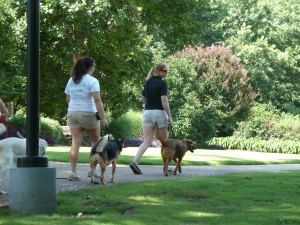Having a nervous, undersocialized, or skittish dog is worrisome to owners. However, as much as we love our dogs, worrying does not help them – it can even make things worse. Dogs are so in tune with our emotions, they become more anxious as we become anxious.
1. Be confident in everything that you do. You want to be a rock for your dog so if he is panicking, he can look up and see a calm leader. Being worried and tense will not help him overcome anything. Always remain calm, confident, and relaxed.
2. Sometimes nervousness can stem from built-up energy. Make sure your dog is getting plenty of exercise.
3. When you see that your dog is afraid, for example passing by a big trashcan, do not coddle or try to coax him by. Instead, walk confidently past and then praise after he accomplished it. Saying things like “It’s ok, it’s alright,” is comforting to humans, but for a dog, you are actually reinforcing his anxious state of mind. Praise him after he has passed the challenging obstacles – “Good boy, you did it!”
4. Go new places often. Dogs do not generalize well, and by going new places, your dog will see that you are confident and in charge wherever you go. Instead of being worried about something new, he will start to see it as a new adventure.
5. Set your dog up to succeed in new places by starting small and building confidence. Instead of expecting your dog to be well behaved around major distractions right away and getting frustrated when things go wrong, build his skills with little distractions. Go places at “off” times when there is less of a crowd, like early morning or midafternoon. Walk around a park and have your dog settle at your feet on a bench, taking the world in calmly. From there, you can build to settling at your feet while you have coffee or lunch. You can also visit pet friendly stores and businesses for added socialization.
6. A tired dog is a good dog! If you are going somewhere new, but are not certain how your dog will behave, it will not hurt to get in a good walk right before. When you arrive at your destination, walking in the parking lot for ten minutes can help settle and relax your dog.
7. If you still struggle or think it is not working with your dog, obedience classes are a great option. Having professionals teach you how to respond properly in different situations could save you much time and frustration. Also, your dog seeing other dogs interacting with confidence will greatly increase their own confidence.
Kersti Nieto
Certified Dog Trainer
K9 Solutions LLC
http://www.nck9solutions.com

